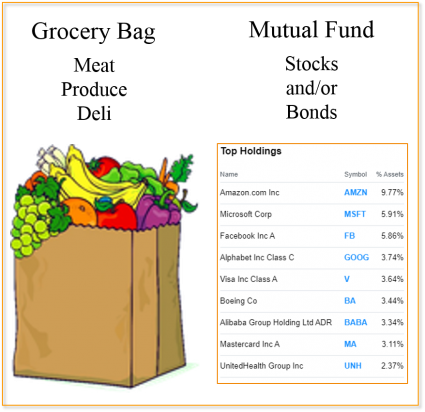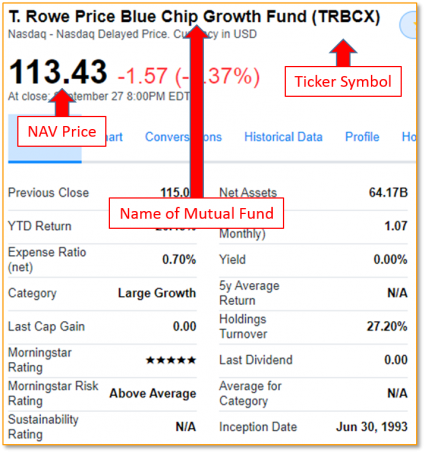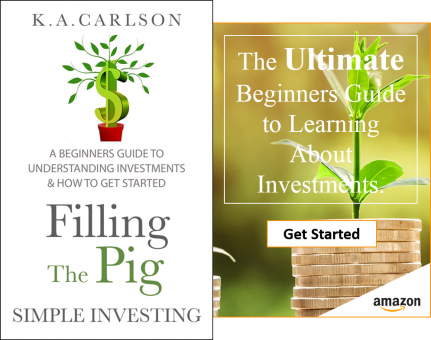If you think investing in mutual funds is hard to do, you’re not alone. It’s a common misconception that mutual funds are tough to understand. Or to start investing in one you need a whole bunch of money. The reality is that mutual funds are one of the easiest ways to start investing. This article is all about mutual funds. What a mutual fund is? Types of mutual funds. The benefits of investing in a mutual fund. Where to buy them. And how much money you need to start investing. But most importantly it provides some mutual fund examples which will help you understand them better.
Think of a mutual fund as the “grocery bag” of investment vehicles. A means of shopping for stocks and bonds. And purchasing a bunch of them all at once.
What is a Mutual Fund?
A mutual fund is a type of investment vehicle that allows investors to pool their money to purchase an assortment of securities at one time. The securities associated with a mutual fund may come in the form of stocks and bonds or a combination of both.
All About Mutual Funds – The Grocery Bag Concept
If you were to go to the grocery store each time you needed an item, you might visit the produce section one time. The deli department another. And the meat department another time. With each visit, you purchase items from a different department.
Visiting the grocery store each time you need an item is similar to creating (shopping) your own investment portfolio. To build your portfolio you would purchase individual stocks, bonds, and other securities.
However, what if you didn’t want to go to the grocery store each time you needed an item. What if you could go to the grocery store once and purchase a grocery bag with all the items you need. Kind of like when you order your groceries from the store and they bag them for you.
Similar to a grocery bag that may contain a variety of items from different departments. Mutual funds contain a number of different securities. A single mutual fund may contain hundreds of different stocks and/or bonds. When you purchase a mutual fund you are investing in all the securities associated with the fund. All the stocks and bonds that make up a mutual fund are called a portfolio (think grocery bag).
Mutual funds are purchased on a per-share basis. The Net Asset Value (NAV) is the share price of a mutual fund. The NAV represents the value of all the assets in the portfolio, less liabilities divided by outstanding shares. Mutual funds are traded on the open market and use a ticker symbol to identify the fund.
However, unlike a stock that can be bought and sold during the day, mutual funds can only be purchased at the end of a trading day.
A Mutual Fund Example
Below is a mutual fund example from Yahoo’s financial summary page. This is a T. Rowe Price mutual fund. Note the name, NAV price, and the ticker symbol.
Below are the stocks (companies) associated with this fund’s portfolio. The stocks shown are only a small portion of all the stocks associated with this mutual fund. The companies listed represent the largest proportion of stock assets contained in this mutual fund.
Benefits of Owning a Mutual Fund
Mutual funds provide investors with some unique qualities. Most notably investment diversification, asset management, simplicity, and accessibility.
Diversification
Because mutual funds may contain hundreds of different stocks, bonds or other securities they inherently provide a level of diversification. Diversification is the ability to minimize risk by spreading your money over multiple securities. Avoiding a situation where any one investment could result in negative performance.
For example, if you were to invest in a stock for a technology company called ABC Tech. The performance of your investment would be based solely on the performance of ABC Tech. If ABC Tech stock does well your return is positive. If ABC Tech stock loses value your return is negative.
However, investing in a mutual fund that contains a whole bunch of technology companies including ABC Tech would diversify your investment across all the companies in the portfolio. If one day ABC Tech were to go out of business any negative performance associated with ABC Tech would be offset by the other companies in the portfolio.
The probability of ABC Tech negatively impacting the overall performance of the mutual fund would be minimized.
Management
A mutual fund is managed by a portfolio or fund manager. The fund manager’s sole purpose is to maximize the return on the mutual fund for its investors. The manager, “manages” the portfolio so you don’t have to.
Most mutual funds are actively managed. Meaning the fund manager uses research, analytics, and past experience to determine what portfolio assets should be bought or sold.
Simplicity, Accessibility, and Affordability
Mutual funds are easy to understand and can be purchased through most online brokerage firms and larger banks. Mutual funds are often found in 401(k) plans and accessible via IRA accounts. In addition, they are affordable. Investing in a mutual fund through an IRA account could be as little as $500.
Related Posts:
- What is an Exchange-Traded Fund (ETF)?
- What is a Real Estate Investment Trust (REIT)? – REIT Investing
- Be Careful! Do You Know What a CDs Auto-Renew Policy Is?
All About Mutual Fund Costs
Like any other investment vehicle, there are always costs associated with buying, selling and managing the investment. Mutual funds are associated with three common expenses.
Expense Ratio
The expense ratio is the annual fee charged for managing the mutual fund. The fee is expressed as a percentage of your investment. For example, a mutual fund with a 1% expense ratio will cost you $10 annually for every $1,000 of investment.
Load
A load expense is a sales commission fee earned by a broker or financial planner when a mutual fund is bought or sold. A front-end load is a fee charged when a mutual fund is purchased. A back-end load is a fee charged when a fund is sold. Not all mutual funds charge a load fee. Funds that do not have a load fee are called no-load funds.
Redemption Fees
A redemption fee is a fee you pay when you sell your shares prematurely. Generally, redemption fees are put in place to discourage active trading, as one would do with a stock. In many cases, there are restrictions on when a mutual fund can be sold. For example, if you sell a mutual fund within 90 days of purchasing the fund a redemption fee may be charged.
How do Mutual Funds Make Money?
Mutual funds make money three ways.
Increase in NAV Price
If you purchase a mutual fund for $20 and in a year the NAV price increases to $30, you’ve made $10 per share. The share price of the mutual fund appreciates in value because the assets in the portfolio have increased in value.
Capital Gains
When assets within a mutual fund are sold a gain is distributed to its shareholders. Capital gains are most often distributed annually to shareholders.
Dividends
Some assets within the fund’s portfolio may pay dividends or interest. When dividends are paid, the mutual fund distributes proceeds to investors. Dividend distributions can be received in cash or redistributed back into the fund to purchase additional shares. Most mutual funds distribute dividends quarterly or annually.
Mutual Fund Examples – Types of Mutual Funds
If there is one negative about mutual funds it’s that there are so many different variations to choose from. This is due to the fact that mutual funds are established with different investment goals and strategies. Some of the most common types of mutual funds are:
Equity (stock) Funds
This category of funds invests primarily in stocks. Within this category are sub-categories of mutual funds that focus on specific types of stocks (companies). For example:
-
- Companies that are perceived as having higher than average growth potential are often found in a growth fund. Mutual Fund Example: Rowe Price Blue Chip Growth (TRBCX)
- Dividend Income. These mutual funds invest in companies that consistently pay a dividend. And have shown an appreciation in dividend income year after year. Mutual Fund Example: Fidelity Dividend Growth Fund (FDGFX)
- Small-cap, mid-cap, large-cap, domestic or foreign are additional examples of mutual funds that invest in a specific type of company (size) or market to achieve a fund’s investment goal. Mutual Fund Example: Vanguard Small- Cap Fund (VSMAX)
Fixed-Income Funds
These types of funds most often invest in debt-based securities like corporate or government bonds. The goal is to distribute interest income to the fund’s shareholders. Mutual Fund Example: BlackRock Core Bond Fund (BFMCX)
Balanced Funds
The goal with balanced funds is to minimize risk for its shareholders by investing in both stocks and bonds. By changing the allocation of assets between stocks and bonds shareholder risk can be mitigated. The allocation may be based on the economic conditions or the strategy of the fund. Asset allocation funds, target-date funds or lifecycle funds are other names for balanced funds. Mutual Fund Example: TIAA-CREF Lifecycle Retirement (TLRIX)
Where to Start Investing in Mutual Funds
Asset management companies like T. Rowe Price, Vanguard and Fidelity create mutual funds. Large banks like Wells Fargo or Bank of America may also provide their own mutual fund investments. Regardless of who manages the assets of a mutual fund, they can be purchased in a variety of different ways.
Direct from the Asset Management Firm
Companies like Wells Fargo, Fidelity or Vanguard actively sell their mutual fund products online. You can open an account online, fund the account and then purchase shares of the mutual fund directly from the firm.
Discount Brokerage Company
Discount brokerage firms like E*TRADE, TD Ameritrade and Charles Schwab allow investors to purchase mutual funds via their online brokerage platforms. For example: rather than purchasing a Vanguard mutual fund from Vanguard you could purchase the fund through a discount brokerage firm. Buying direct from an asset management company will generally allow you to purchase their mutual funds with no trading fee. Whereas a discount brokerage firm will charge a fee to buy and sell a fund.
Robo-Advisors and Automated Investing Platforms
In many cases, automated investing platforms use Exchange Traded Funds (ETF) as an investment vehicle. However, mutual funds have also found their way into robo-advisor platforms. E*TRADE, and Charles Schwab both provide automated investing platforms that leverage mutual funds as an investment vehicle.
Not familiar with automated investing platforms? Be sure to read Understanding Robo-Advisors and Automated Investing
Employer-Sponsored 401(k)
If you contribute to your employer’s 401(k) account it is likely you have access to a select portfolio of target-date funds. Target date funds are a type of mutual fund. And are designed to simplify the selection of a fund for retirement planning purposes.
To learn more about target-date mutual funds be sure to read, What is a Target Date Fund?
Individual Retirement Account (IRA)
IRA accounts provide tax-deferred investing. Most financial institutions, discount brokerage firms and asset management companies provide IRA accounts. When opening an IRA account most institutions provide mutual funds as an investment option.
Learn more about mutual funds and their tax benefits of opening a Traditional IRA account by reading Lower Your Taxes and Start Investing by Opening a Traditional IRA Account For Retirement
How Much Does it Cost to Invest in Mutual Funds
The minimum amount of funds required to invest in a mutual fund will vary depending on the type of account you open.
Standard brokerage accounts will often require a $2,000-$3,000 minimum.
Contributions to a 401(k) account are often reflected as a percentage of your salary.
IRA accounts generally have a lower starting minimum of $500-$1,000.
Choosing the Right Mutual Fund
As discussed earlier there are literally thousands of mutual funds. In fact, a 2018 survey found a total of 9599 different types of mutual funds. So, the obvious question is how do you select the right mutual fund for your investment strategy.
Mutual Fund Screening
Screening is a way of narrowing down the types of mutual funds you may choose to invest in. Most brokerage firms, asset management companies, and large finance sites provide a screening tool to help with this process. Screening allows you to evaluate mutual funds based on category, fund family, performance, and expense ratios – just to name a few. An example of a mutual fund screener is Yahoo’s Finance Mutual Fund Screener.
Third-Party Ratings
Rating a mutual fund is a way of ranking a fund based on its past performance. The higher the rating the better the mutual fund. Ratings can be based on a number of different criteria. However, most often are based on past performance, expense ratios, risk. And the tenure of the fund manager.
More Mutual Fund Examples and Videos:
- How to Research a Mutual Fund (Video) – How to Screen Mutual Funds
- How to Track Stocks and Mutual Funds using Yahoo Finance (Video)
One of the most prominent third-party firms to rate mutual funds is Morningstar. They have been evaluating and ranking mutual funds for years. A mutual fund rating will often include the Morningstar assessment.
To learn more about Morningstar and their rating system be sure to read: Who is Morningstar and Why Should I Care?
The Final Word About Mutual Funds
For many, the approach to making more money is to work harder or find a higher paying job. Rather than spending some time thinking about how to make more money with the money they already have. That’s where mutual funds come in.
Mutual funds are another option that can provide the average investor with numerous investment choices. Mutual funds are most appealing because they provide a level of diversification that other investment vehicles do not. There is a level of comfort knowing a professional is handling your investment.
If you’re just starting to think about retirement planning, or maybe want to expand your investment options. Mutual funds may be another investment vehicle to expand your portfolio.
Recommended Resources:
- Common Sense on Mutual Funds
- Motley Fool Stock Advisor
- Personal Capital – All Your Financial Tools in One Place
- Wealthsimple – Automated Investing, Open an IRA Account, No Account Minimum
Do you invest in Mutual Funds? Comment below.






Hello, do you allow guest posting on fillingthepig.com ? 🙂 Please let me know on my e-mail
I do, please send your article to kevin@fillingthepig.com and I will review and get it uploaded for you. Thanks